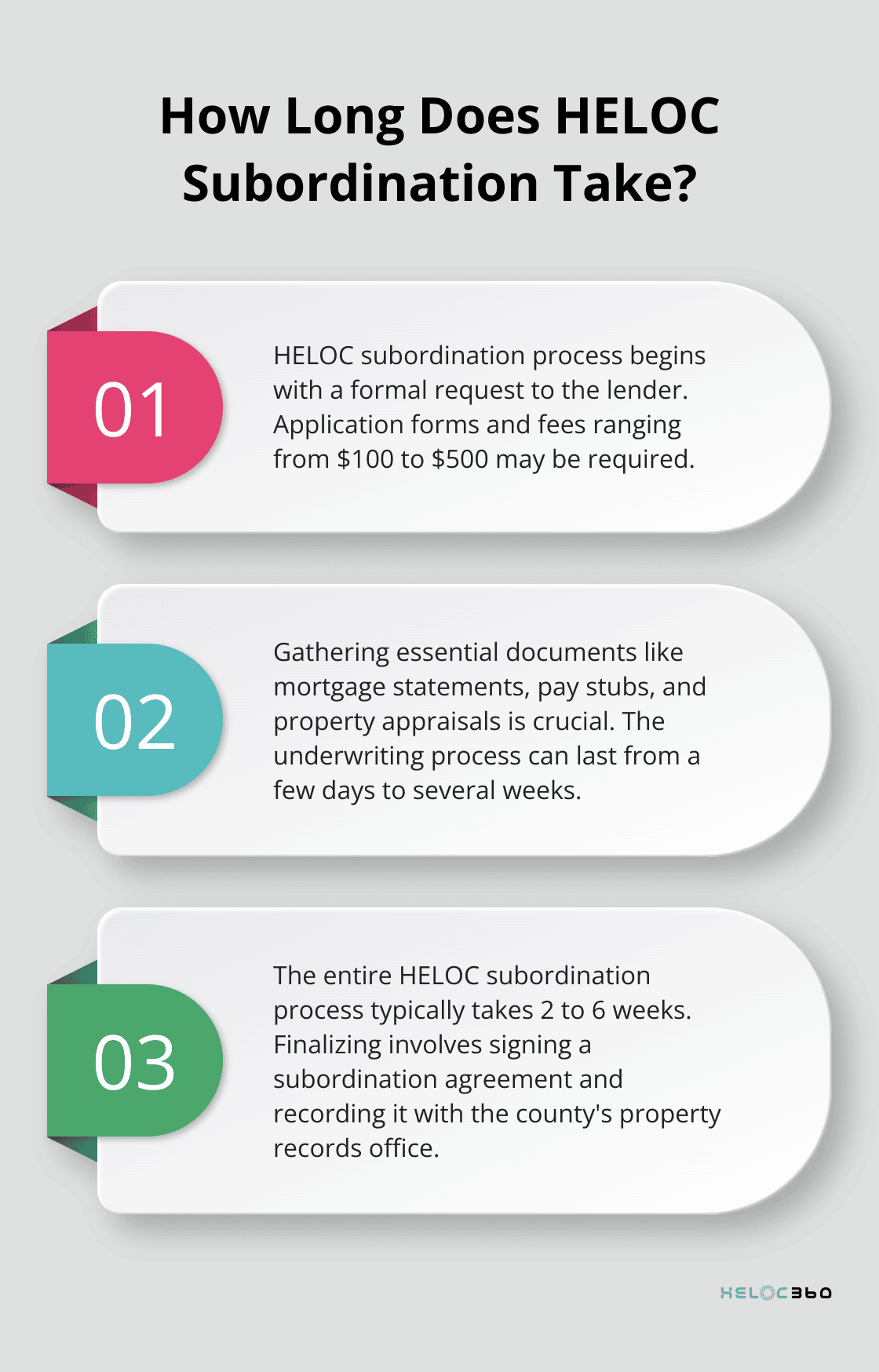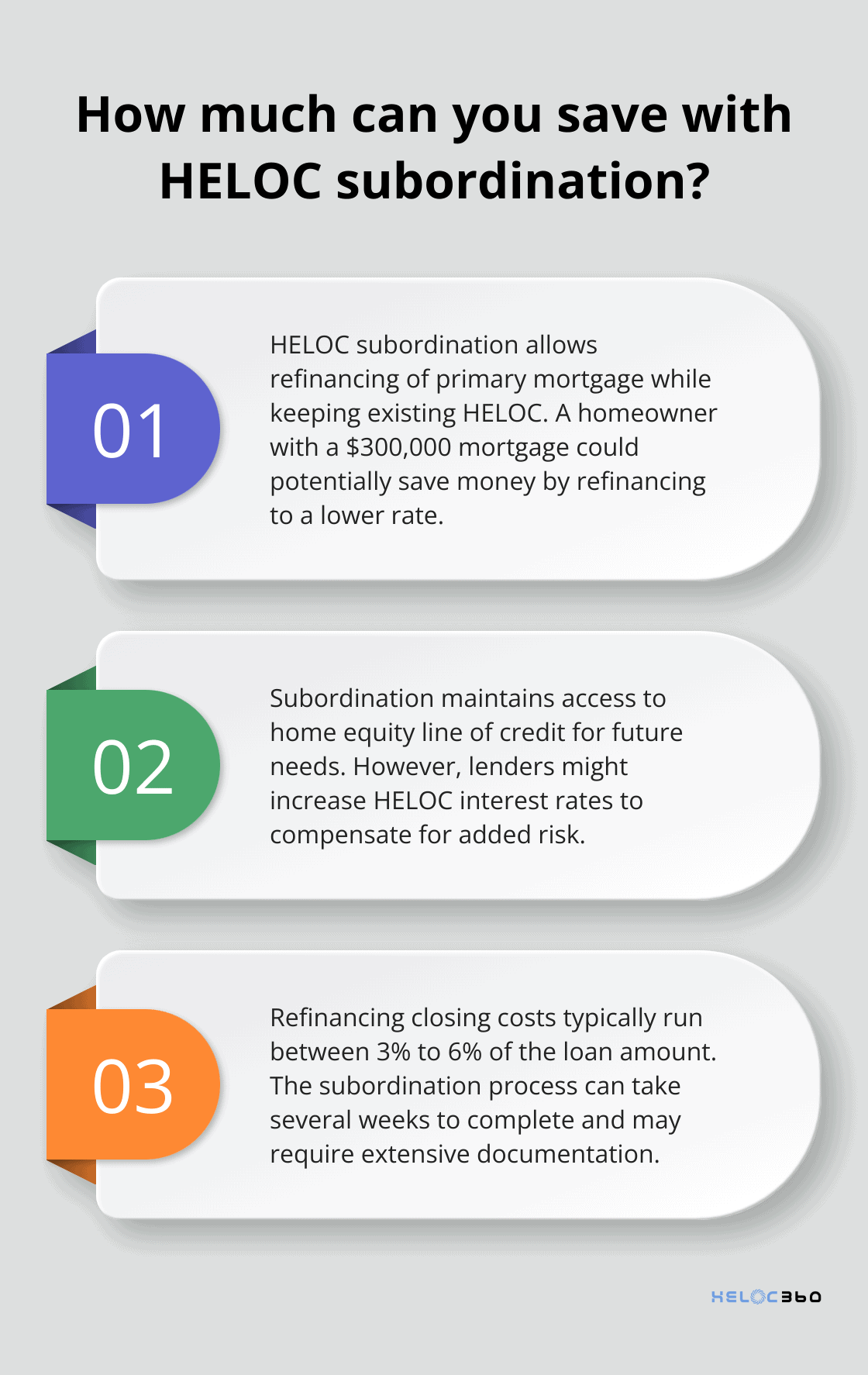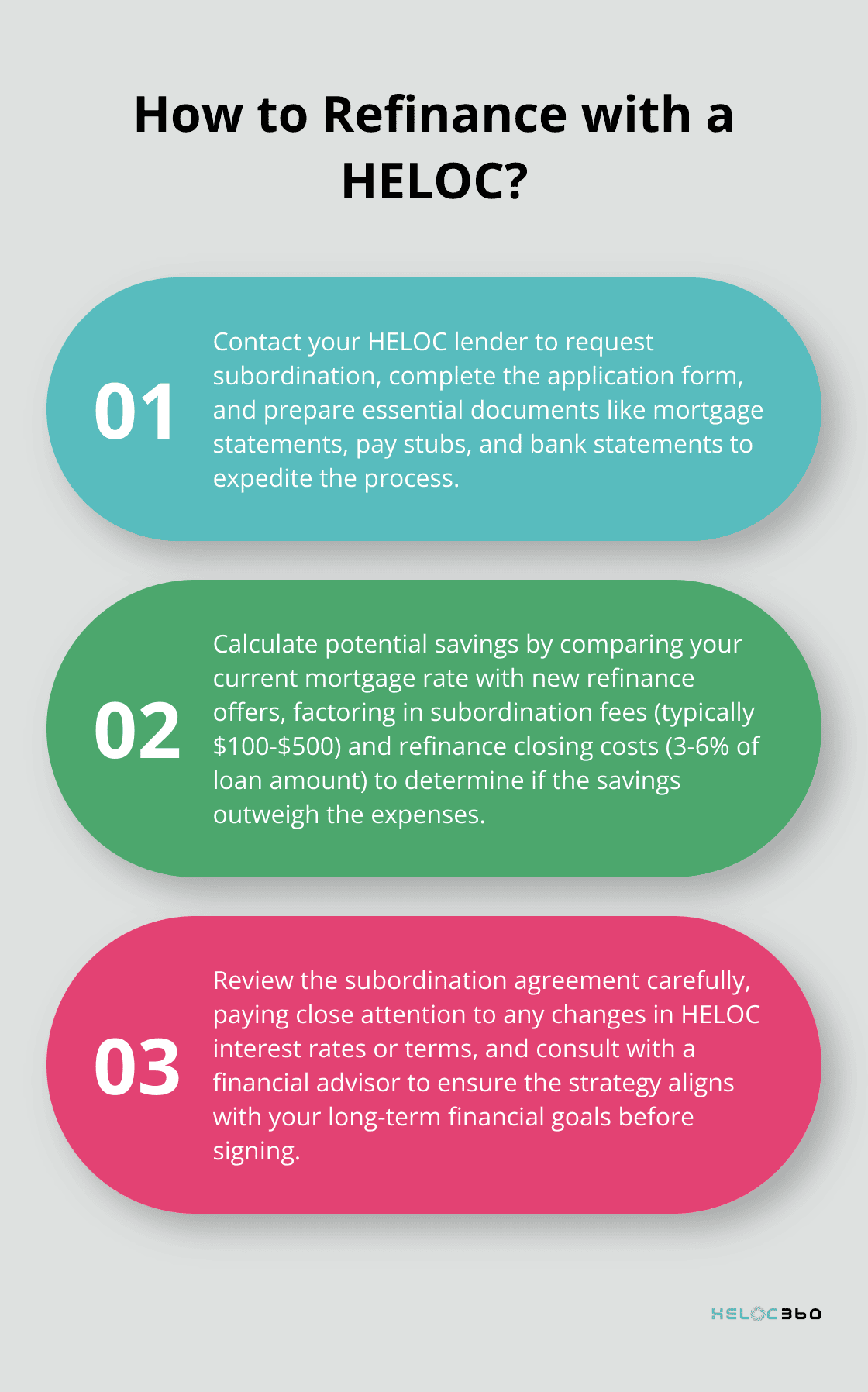- ***PAID ADVERTISEMENT**
- ACHIEVE LOANS – HOME EQUITY EXPERTISE
- FLEXIBLE FINANCING SOLUTIONS
- PERSONALIZED SUPPORT
- RECOMMENDED FICO SCORE: 640+
- COMPETITIVE RATES STREAMLINED APPLICATION PROCESS
HELOC subordination can be a game-changer for homeowners looking to refinance their mortgage or secure additional financing. This process involves adjusting the priority of your home equity line of credit in relation to other loans secured by your property.
At HELOC360, we understand that navigating HELOC subordination can be complex. In this guide, we’ll break down the essentials, explore the pros and cons, and provide you with the information you need to make informed decisions about your home equity.


- Approval in 5 minutes. Funding in as few as 5 days
- Borrow $20K-$400K
- Consolidate debt or finance home projects
- Fastest way to turn home equity into cash
- 100% online application
What Is HELOC Subordination?
Definition and Purpose
HELOC subordination is a financial strategy that alters the priority of your home equity line of credit (HELOC) in relation to other loans secured by your property. This process typically involves moving your HELOC to a lower priority position, usually behind a new first mortgage.
Reasons for HELOC Subordination
Homeowners often pursue HELOC subordination when they refinance their primary mortgage. For instance, if you want to capitalize on lower interest rates by refinancing your first mortgage, you’ll need your HELOC lender to agree to remain in second position. This allows you to maintain your HELOC while benefiting from improved terms on your primary loan.

A HELOC is now cheaper than a refi. While the interest rate on a HELOC today is probably higher than the rate on a primary mortgage, homeowners will likely to consider this option.
Effects on Your HELOC
Subordination of your HELOC doesn’t alter its terms. Your credit limit, interest rate, and repayment schedule remain unchanged. However, it does impact the lender’s position in case of a foreclosure.
A subordinated HELOC drops in repayment priority. This means if you default on your loans and your home faces foreclosure, the primary mortgage lender receives payment first from the sale proceeds. The HELOC lender only receives payment if funds remain after satisfying the primary mortgage.
The Subordination Process
To start HELOC subordination, you must contact your HELOC lender and request their agreement to subordinate. This process can take anywhere from a few days to several weeks, depending on the lender’s policies and workload.
Most lenders require you to meet specific criteria before agreeing to subordinate. These may include:
- A solid payment history on your HELOC
- Adequate equity in your home
- A robust credit score
- A combined loan-to-value ratio (CLTV) that falls within their guidelines
It’s important to note that some lenders charge a fee for subordination (ranging from $100 to $500 or more). Always inquire about associated costs upfront to avoid unexpected expenses later in the process.
Considerations for Homeowners
When contemplating HELOC subordination, homeowners should weigh several factors. The potential benefits of refinancing your primary mortgage (such as lower monthly payments or a shorter loan term) should outweigh the costs and effort involved in the subordination process.
Additionally, you should consider your long-term financial goals. If you plan to use your HELOC for future expenses, ensure that subordination won’t limit your ability to access the funds you need.
As you navigate the complexities of HELOC subordination, it’s crucial to understand the steps involved in the process. Let’s explore the HELOC subordination procedure in more detail.
How to Navigate the HELOC Subordination Process
Initiating the Subordination Request
The HELOC subordination process starts when you contact your HELOC lender to formally request subordination. You’ll need to complete a subordination application form, which asks for details about your current HELOC, the new loan you seek, and your financial situation. Be aware that some lenders charge a fee for this service (ranging from $100 to $500 or more).
Gathering Essential Documents
To process your subordination request, lenders require a comprehensive set of documents. These typically include:
- Your current mortgage statement
- Recent pay stubs and W-2 forms
- Bank statements from the past few months
- The new loan’s terms and conditions
- A current property appraisal

The exact requirements vary between lenders, so ask for a detailed checklist upfront. Having these documents ready will speed up the process significantly.
Underwriting and Approval
After you submit your application and supporting documents, the lender’s underwriting team reviews your request. They assess factors such as your credit score, payment history, and the combined loan-to-value ratio (CLTV) of your property. The CLTV ratio is determined by dividing the sum of the items listed below by the lesser of the sales price or the appraised value of the property.
The underwriting process can last from a few days to several weeks, depending on the lender’s workload and the complexity of your financial situation. During this time, respond promptly to any additional information requests from the lender.
Finalizing the Agreement
If the lender approves your subordination request, they draft a subordination agreement. This legal document outlines the new priority of your loans and confirms that your HELOC will take a secondary position to your new primary mortgage.
Review this agreement carefully, paying close attention to any terms or conditions attached to the subordination. If you’re unsure about any aspect of the agreement, seek clarification from your lender or consult with a financial advisor.
Completing the Process
The final step involves signing the subordination agreement and returning it to your HELOC lender. They will then record this document with your county’s property records office. This official recording ensures that the new lien positions are legally recognized.
From start to finish, the entire HELOC subordination process typically takes between 2 to 6 weeks. However, this timeline can vary based on factors such as lender efficiency, the complexity of your financial situation, and how quickly you provide the required documentation.
Now that you understand the steps involved in HELOC subordination, it’s important to weigh the advantages and potential drawbacks of this financial strategy. Let’s explore the pros and cons of HELOC subordination in the next section.
Is HELOC Subordination Right for You?
Advantages of HELOC Subordination
HELOC subordination offers significant benefits for homeowners. It allows you to refinance your primary mortgage while keeping your existing HELOC. This can lead to substantial savings if you secure a lower interest rate on your first mortgage. For instance, a homeowner with a $300,000 mortgage could potentially save money by refinancing to a lower rate.

Another advantage is the flexibility it provides. Subordinating your HELOC maintains your access to your home equity line of credit, which serves as a valuable financial resource for future needs or emergencies. This proves particularly beneficial if you’ve already drawn on your HELOC and don’t want to lose that borrowed amount in a refinance.
Potential Drawbacks to Consider
HELOC subordination, while advantageous, comes with certain risks. A significant drawback is the potential for higher interest rates on your HELOC. When a lender agrees to subordinate, they accept a higher level of risk. As a result, they might increase the interest rate on your HELOC to compensate for this added risk.
Another consideration is the time and effort the subordination process requires. It can take several weeks to complete, and you may need to provide extensive documentation. This can delay your refinancing process and potentially cause you to miss out on favorable interest rates if they rise during the waiting period.
Financial Implications for Homeowners
The financial impact of HELOC subordination can be substantial. On the positive side, if you refinance your primary mortgage at a lower rate, you could see significant monthly savings.
However, you must factor in the costs associated with subordination. Some lenders charge fees for this service. Additionally, you’ll need to consider the closing costs of your refinance, which typically run between 3% to 6% of the loan amount.
It’s also important to consider the long-term implications. While lower monthly payments can provide immediate relief, extending your loan term could result in paying more interest over time. Always calculate the total cost of the loan, not just the monthly payment, when making your decision.
Weighing Your Options
To determine if HELOC subordination is right for you, consider your current financial situation and long-term goals. Ask yourself:
- Will the savings from refinancing outweigh the costs of subordination?
- Do you need continued access to your HELOC funds?
- Can you afford potentially higher HELOC interest rates?
- Does this align with your overall financial strategy?
A thorough analysis of your specific circumstances is recommended before proceeding. Consider consulting with a financial advisor to ensure this strategy aligns with your long-term financial goals.
Final Thoughts
HELOC subordination empowers homeowners to optimize their mortgage strategy while maintaining access to their home equity. This process offers flexibility and potential cost savings, but homeowners must weigh the benefits against potential drawbacks such as higher HELOC interest rates and fees. A thorough analysis of your financial situation, long-term goals, and risk tolerance should guide your decision to pursue HELOC subordination.

Financial professionals can provide personalized advice tailored to your specific circumstances. HELOC360 understands the intricacies of HELOC subordination and its impact on your overall financial picture. Our platform helps you navigate the world of home equity with confidence, providing expert guidance and connecting you with suitable lenders.
Your home’s equity is a valuable asset, and HELOC subordination is one of many strategies to leverage it effectively. HELOC360 supports you in making informed decisions about your home equity options. We offer tools and resources to help you work towards achieving your financial aspirations, whether you consider HELOC subordination or explore other home equity solutions.
Our advise is based on experience in the mortgage industry and we are dedicated to helping you achieve your goal of owning a home. We may receive compensation from partner banks when you view mortgage rates listed on our website.
